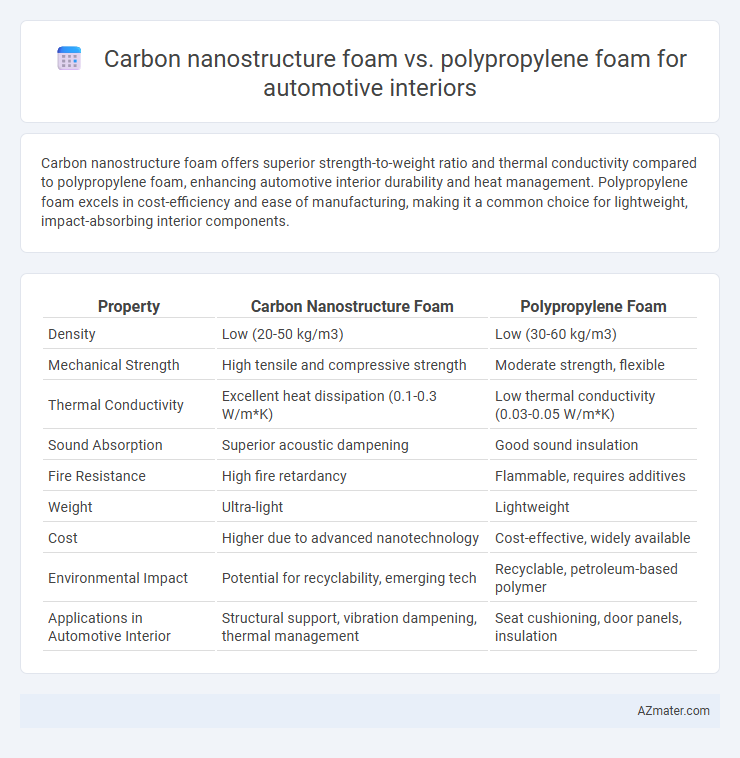Carbon nanostructure foam offers superior strength-to-weight ratio and thermal conductivity compared to polypropylene foam, enhancing automotive interior durability and heat management. Polypropylene foam excels in cost-efficiency and ease of manufacturing, making it a common choice for lightweight, impact-absorbing interior components.
Table of Comparison
| Property | Carbon Nanostructure Foam | Polypropylene Foam |
|---|---|---|
| Density | Low (20-50 kg/m3) | Low (30-60 kg/m3) |
| Mechanical Strength | High tensile and compressive strength | Moderate strength, flexible |
| Thermal Conductivity | Excellent heat dissipation (0.1-0.3 W/m*K) | Low thermal conductivity (0.03-0.05 W/m*K) |
| Sound Absorption | Superior acoustic dampening | Good sound insulation |
| Fire Resistance | High fire retardancy | Flammable, requires additives |
| Weight | Ultra-light | Lightweight |
| Cost | Higher due to advanced nanotechnology | Cost-effective, widely available |
| Environmental Impact | Potential for recyclability, emerging tech | Recyclable, petroleum-based polymer |
| Applications in Automotive Interior | Structural support, vibration dampening, thermal management | Seat cushioning, door panels, insulation |
Introduction to Automotive Interior Foams
Automotive interior foams must balance lightweight properties with durability, comfort, and thermal insulation. Carbon nanostructure foam offers superior mechanical strength, electrical conductivity, and thermal stability compared to traditional polypropylene foam, which is more commonly used due to its cost-effectiveness and ease of manufacturing. Advances in carbon-based nanomaterials are driving innovations in automotive interiors by enhancing noise reduction, impact resistance, and fire retardancy while maintaining sustainable lightweight design.
Overview of Carbon Nanostructure Foam
Carbon nanostructure foam offers superior strength-to-weight ratio, exceptional thermal conductivity, and enhanced durability compared to traditional polypropylene foam in automotive interiors. Its porous architecture provides excellent energy absorption and improved noise reduction, making it ideal for lightweight and safe vehicle components. Advanced carbon nanostructure materials contribute to sustainable manufacturing through increased recyclability and reduced environmental impact.
Key Properties of Polypropylene Foam
Polypropylene foam exhibits excellent lightweight characteristics and high impact resistance, making it a versatile choice for automotive interior applications where durability and weight reduction are critical. Its thermal insulation properties and chemical resistance contribute to enhanced passenger comfort and long-term material stability in varying temperature and humidity conditions. Unlike carbon nanostructure foam, polypropylene foam offers cost-effectiveness and ease of manufacturing, supporting mass production while maintaining sufficient mechanical performance for interior components.
Comparative Mechanical Strength: Carbon Nanostructure vs Polypropylene
Carbon nanostructure foam exhibits superior mechanical strength compared to polypropylene foam, offering enhanced tensile strength and impact resistance essential for automotive interior applications. The high modulus and lightweight nature of carbon nanostructure foam contribute to improved structural integrity while maintaining weight efficiency. In contrast, polypropylene foam, though cost-effective and flexible, typically presents lower stiffness and less durability under mechanical stress.
Thermal Insulation Performance
Carbon nanostructure foam exhibits superior thermal insulation performance compared to polypropylene foam in automotive interiors due to its low thermal conductivity and high heat resistance. The interconnected porous network in carbon nanostructure foam effectively reduces heat transfer, enhancing cabin temperature regulation and energy efficiency. In contrast, polypropylene foam offers moderate insulation but lacks the advanced thermal stability and conductivity control found in carbon nanostructure materials.
Weight and Density Implications for Vehicle Design
Carbon nanostructure foam exhibits significantly lower density, typically around 0.1 to 0.3 g/cm3, compared to polypropylene foam's density range of 0.9 to 1.2 g/cm3, translating directly into reduced weight for automotive interior components. This reduction in material density enables vehicle designers to achieve enhanced fuel efficiency and improved overall vehicle performance by lowering curb weight without compromising structural integrity. The superior strength-to-weight ratio of carbon nanostructure foam supports innovative lightweight design strategies critical for meeting stringent emission regulations and increasing electric vehicle range.
Acoustic Insulation Capabilities
Carbon nanostructure foam exhibits superior acoustic insulation capabilities compared to polypropylene foam, effectively attenuating a broader range of sound frequencies typical in automotive interiors. Its nanoscale porous network enhances sound absorption and minimizes vibration transmission, contributing to reduced cabin noise levels. Polypropylene foam, while lightweight and cost-effective, offers moderate sound dampening primarily through its cellular structure but lacks the advanced acoustic performance of carbon-based nanomaterials.
Environmental Impact and Recyclability
Carbon nanostructure foam offers superior environmental benefits over polypropylene foam in automotive interiors due to its lightweight properties and higher durability, which contribute to reduced vehicle emissions and improved fuel efficiency. While polypropylene foam is widely recyclable through established industry processes, carbon nanostructure foam presents emerging recycling methods that focus on energy-efficient recovery and reuse, minimizing landfill waste. The integration of carbon nanostructure foam supports automotive manufacturers in meeting stringent environmental regulations and sustainability goals by enhancing lifecycle performance and reducing the overall carbon footprint.
Cost-Effectiveness for Mass Production
Carbon nanostructure foam offers superior strength-to-weight ratio and enhanced thermal and acoustic insulation compared to polypropylene foam, making it an advanced alternative for automotive interior applications. However, polypropylene foam remains significantly more cost-effective for mass production due to its established manufacturing processes and lower raw material expenses. The trade-off between performance and production cost positions polypropylene foam as the preferred choice for large-scale automotive interior components where budget constraints are critical.
Future Trends in Automotive Interior Materials
Carbon nanostructure foam offers superior strength-to-weight ratio and enhanced thermal conductivity compared to polypropylene foam, making it ideal for next-generation automotive interiors focused on performance and sustainability. Emerging trends highlight the integration of lightweight, multifunctional materials like carbon nanostructure foam to improve vehicle efficiency, noise reduction, and passenger comfort. Polypropylene foam remains relevant due to its cost-effectiveness and recyclability, but advancements in nanomaterial composites are expected to drive a shift towards more innovative, high-performance interior components.

Infographic: Carbon nanostructure foam vs Polypropylene foam for Automotive Interior
 azmater.com
azmater.com